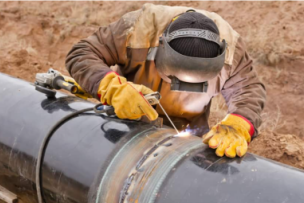As a brand of Saint-Gobain, a world leader in sustainable habitat, Norton offers the widest portfolio of grinding, cutting, blending, finishing and polishing solutions for all markets, materials and applications with the most advanced and affordable technology. So, as your needs evolve, our access to the global expertise of Saint-Gobain becomes even more valuable to making a difference in your day-to-day needs. And, we don’t have to look far for more localized expertise with our largest research center located right nearby in Northboro, MA.
Coated abrasive flap discs are becoming more popular in the metal fabrication and finishing industries. These products are commonly used on portable electric and pneumatic angle grinders instead of grinding wheels and coated abrasive discs. Because of this increased popularity, it is good to have a refresher on flap disc safety, focusing on the three areas where most problems may arise.
1. PROPER GRINDING ANGLE AND SURFACE
It is important to use flap discs at the correct angle and on the correct surface. Using the incorrect angle or surface can cause epoxy wear, backing disc damage, or snagging. All of these can lead to separation of the flaps or backing disc breakage. Type 27 flap discs should be used at 0°-15° angle and Type 29 flap discs should be used at 15°-25° angle to the workpiece. Do not use flat or on the edge.

2. GUARDS
There is a common misconception that guards are not required when using coated abrasive products. This is simply not true. ANSI B7.7 Safety Requirements for Abrading Materials with Coated Abrasive Systems very clearly states that “If the machine is designed and equipped with guards, it shall not be operated without the guards properly installed and in place.” Flap discs are designed for use on angle grinders, which come equipped with guards. In addition, the 2017 revision of ANSI B7.1 Safety Requirements for the Use, Care and Protection of Abrasive Wheels makes specific mention of requirements for flap disc wheels: “Type 27 and 29 abrasive flap disc wheels are subject to all limitations of mounting and use listed for Type 27 wheels.” B7.1 goes on further to state, “These wheels are recommended only for use on specially designed and guarded machines.” Make sure your grinder has the proper guard, that it is in good condition, and that it is positioned between you and the disc. Should a breakage or flap separation occur, the guard is designed to contain the pieces and protect you from injury. Never use a grinder without a guard!
3. INSPECTION/HANDLING
Inspect flap discs for any signs of damage prior to using. A disc that has been dropped or otherwise mishandled can be damaged, which can lead to breakage. Do not use a disc that has been dropped or damaged.
OTHER DO’S AND DON’TS
In addition to these three areas, it is important to follow the basic do’s and don’ts for flap discs to ensure they are used properly and safely.
DO’S
- Do store abrasive flap discs at the recommended 40-50% relative humidity and 60-80° F (15 to 29° C). Store in their original containers, keeping them away from water or other fluids.
- Do rotate stock. Use flap discs on a first in, first out basis.
- Do comply with ANSI B7.7, OSHA, and all safety materials provided with the flap discs, machines, and the tools.
- Do disconnect the tool from the power supply before changing a flap disc.
- Do match flap disc size with grinder/sander (e.g. 7" flap disc for a 7" grinder/sander).
- Do check machine speed against established safe operating speed marked on the flap disc. Never exceed the rated speed of a flap disc.
- Do wear proper personal protection such as ANSI approved impact-resistant eye and face protection, arm guards, apron, gloves, safety shoes, hearing protection, etc. The use of a respirator is required where harmful materials may be produced by the operation, such as wood dust, toxic metal particles, etc.
- Do test run your flap disc in an enclosed area such as a barrel at operating speed for one full minute before using it.
- Do use side handle when furnished with your angle grinder/sander.
- Do review all applicable SDS (Safety Data Sheets) before using this product. Safety data sheets for Norton flap discs can be found using the SDS finder.
- Do contact your abrasive manufacturer if you have any safety questions.
DON’TS
- Don’t use on pistol grip air sanders or any other improper tool.
- Don’t store abrasive flap discs on concrete floors, near open windows, in direct sunlight, or near heat sources such as radiators or steam pipes.
- Don’t wear any loose clothing, jewelry, or any item that may snag onto moving equipment.
- Don’t exceed the maximum RPM marked on the flap disc.
- Don’t install a flap disc onto a machine NOT in good working condition.
- Don’t jam the flap disc into a workpiece.
- Don’t create a hazard. Shield any nearby bystanders and any flammable materials from the spark/debris stream (shower).
- Don’t allow the flap disc to “load up” with the material you are abrading.
- Don’t use a flap disc if you have not reviewed all of the safety materials and have not been properly trained in the use of the tool and flap disc.
For additional information on this topic or if you need any other abrasive safety information, please review the Norton Product Safety page, ANSI, OSHA, and all literature provided by the coated abrasive and machine manufacturer. You may contact the Saint-Gobain Product Safety Department at (508) 795-2317, Fax (508) 795-5120, or contact your Saint-Gobain Abrasives representative with any safety related questions.
Previously Featured on Norton's Resources page.








Talk to Us!
Leave a reply
Your email address will not be published. Required fields are marked *